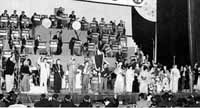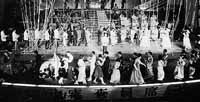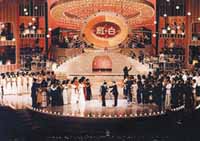
| New Year's Eve in Japanese homes wouldn't be the same without the Red & White Year-end Song Festival. NHK's entertainment programs have always been family-oriented. |
Red & White Year-end Song Festiva: the events and songs of the year just ending |
|
From radio to TV
|
Changing times The Kishi Cabinet resigned after forcing the new US-Japan Security Treaty through the Diet. The 1960's, during which the new Ikeda cabinet promoted a policy of economic growth and a doubling of personal income, was an era of great change and new ideas. The music industry flourished, with the emergence of Japanese popular music, Western pop, folk, and the group sound. By the time of the 14th edition (1963), most of the prominent pre-war singers had retired from the scene, marking a generational change. The audience share for that year's show was an unprecedented 81.4%. By then, Red & White Year-end Song Festival was not just an annual NHK program, but the biggest event in the entire music industry—and a national event. In the 17th edition(1966), backed by a boom in group sounds and the popularity of folk songs, Jacky Yoshikawa and the Blue Comets and Mike Maki appeared for the first time, bringing a wind of change to the contest. The 1970's saw the rise to fame of teenage songsters. Yamaguchi Momoe, Mori Masako, and Sakurada Junko, who were still junior-high school students at the peak of their popularity, were dubbed the "Schoolgirl Trio." In the 29th edition in 1978, pop songs by Yamaguchi Momoe and Sawada Kenji replaced the traditional enka ballads as the final songs of the year. Many of today's karaoke favorites are from the 1970's, and were originally featured in Red & White Year-end Song Festival. The program has been broadcast in Brazil via satellite since the 26th edition (1975). It can now be seen in 92 countries and regions of the world. Era of transition In 1989, the postwar queen of Japanese popular music, Misora Hibari, died. This was a time of transition for the Red & White Year-end Song Festival, and the 40th show in 1989 made some big changes. Instead of starting at 9:00 p.m. as in the past, it ran 4 h 25 min, from 7:20 p.m. to 11:45 p.m. The first part consisted of comments by celebrities and songs on the theme of Japan's postwar history. Then came a five-minute news bulletin. The second part consisted of hit songs of the year. The extended version of Red & White Year-end Song Festival started a new tradition for the Heisei era. Reflecting the changing world of popular music, the Red & White Year-end Song Festival remains a firm favorite to the present day. To appear on the show is still a dream come true for any Japanese singer. |
 1953: first television relay (from Nichigeki Hall) |
 1963: record audience share of 81.4% |
 1973: public show at NHK Hall for the first time |
